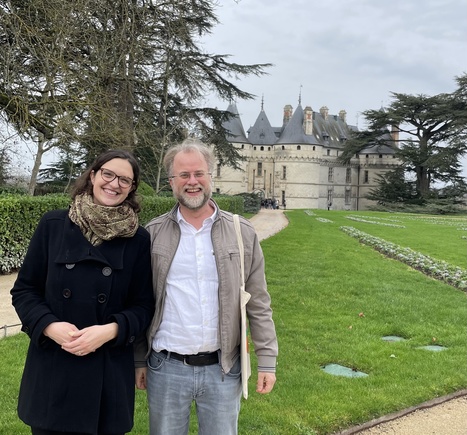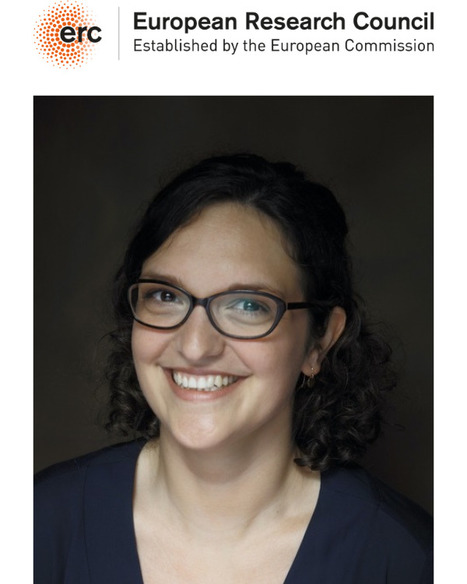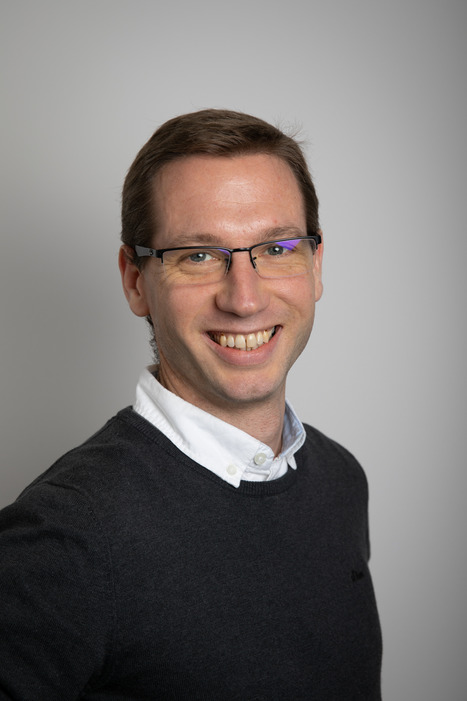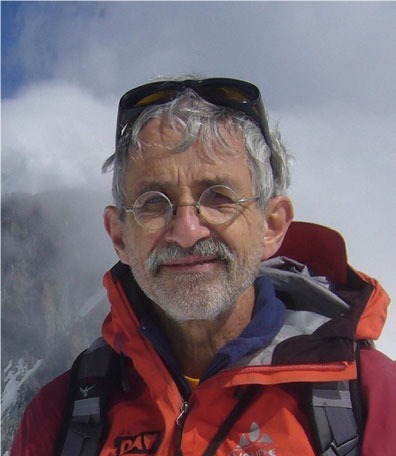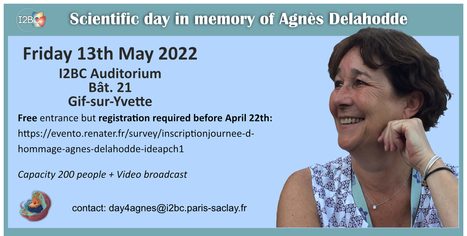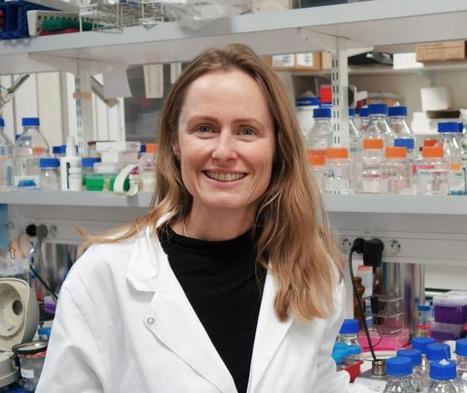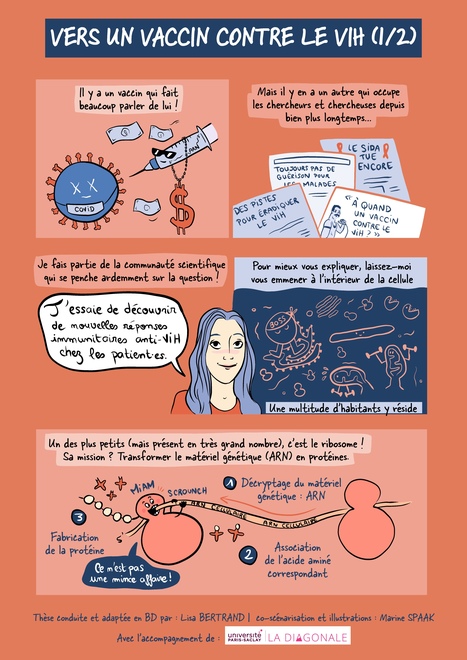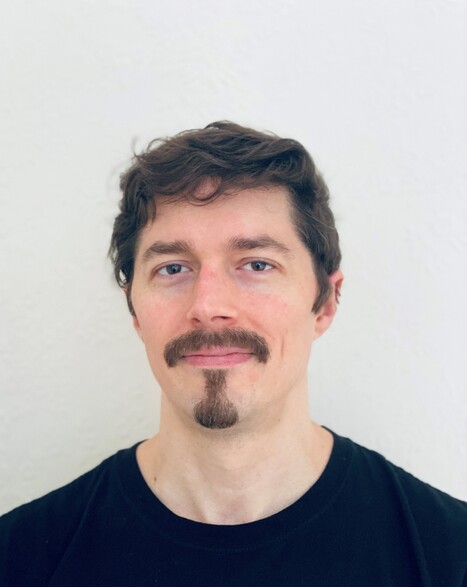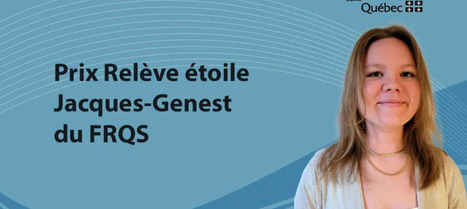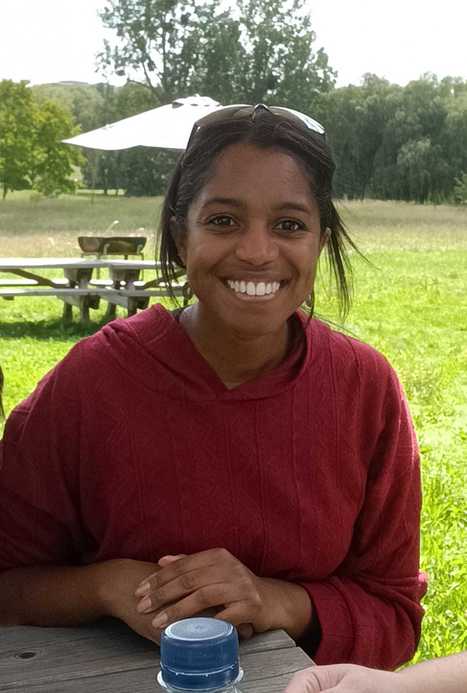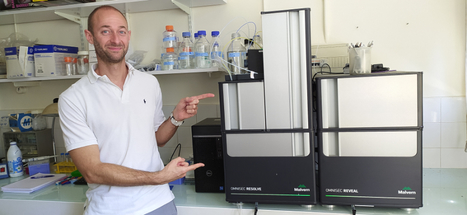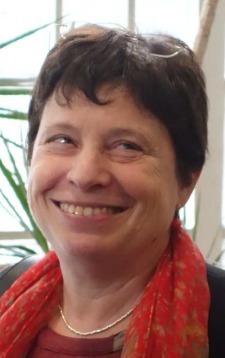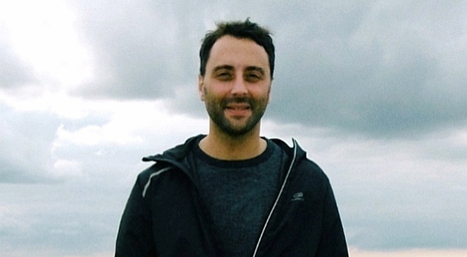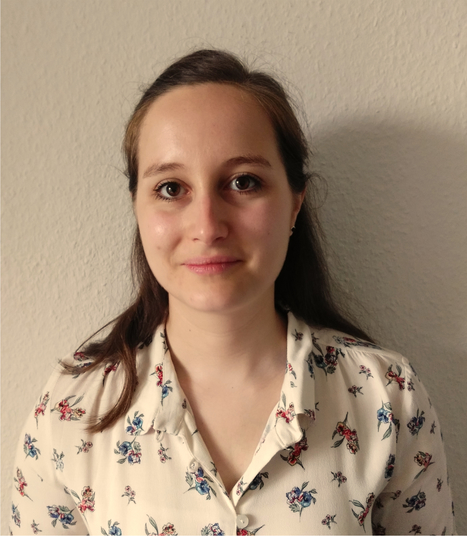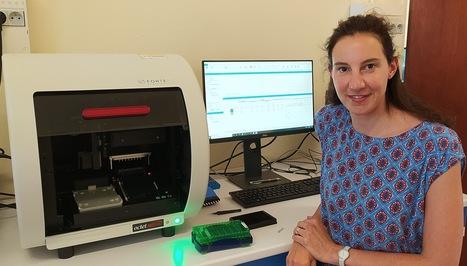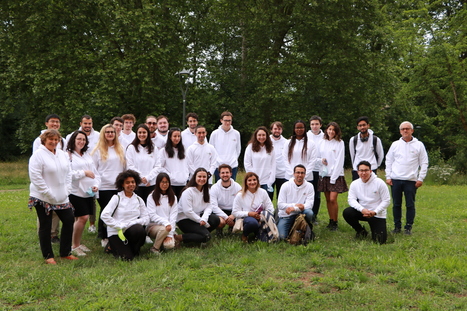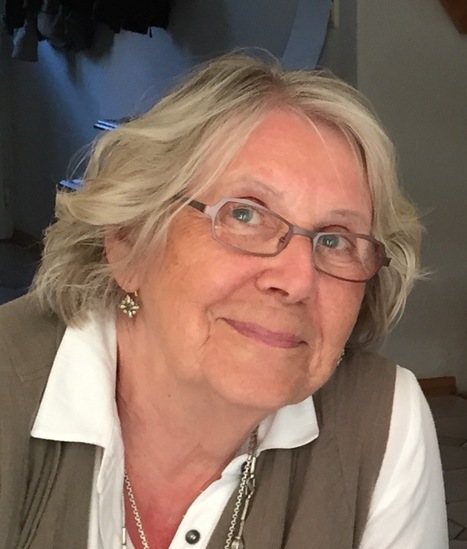 Your new post is loading...
 Your new post is loading...

|
Scooped by
I2BC Paris-Saclay
January 16, 8:23 AM
|
Newcomer at the BIOI2 bioinformatics platform
Baptiste Roelens joined the BIOI2 platform last month, bringing expertise in machine learning for biological data analysis. His contributions will expand the platform's service offerings and support the I2BC imaging community. The integrative BIOinformatics platform (BIOI2) welcomes Baptiste Roelens as a new engineer. Baptiste's background combines theoretical computer science and life sciences, with a foundation from Ecole Polytechnique. He further honed his skills at the Institut Curie, where he earned his PhD. His doctoral research focused on developing quantitative approaches to analyze the role of the histone chaperone CAF-1 in maintaining higher-order chromatin structure during meiotic prophase in the fruit fly. Continuing his research journey, Baptiste joined Stanford University to develop bioimage analysis pipelines, further exploring the mechanisms regulating chromosome organization and cell-cycle progression in C. elegans germline. Upon returning to France, he contributed to the biotech company Viroxis, developing cutting-edge deep-learning approaches for protein design. With experience spanning both wet and dry labs, Baptiste will be a great asset to the BIOI2 platform and is ideally placed to collaborate with the I2BC’s imaging community, in particular the Imagerie-Gif platform (https://www.i2bc.paris-saclay.fr/bioimaging/), to develop pipelines that streamline the processing and analysis of complex imaging data. BIOI2 provides access to bioinformatics resources and activities developed and of use at the I2BC, organises focused training session on bioinformatics tools, and is an official contributing plateform of the nationwide French Institute of Bioinformatics (IFB). More information: https://bioi2.i2bc.paris-saclay.fr Contact: contact-bioi2@i2bc.paris-saclay.fr

|
Scooped by
I2BC Paris-Saclay
March 25, 2024 9:45 AM
|
Bettencourt-Schueller Foundation seminar on Art & Science: How does creativity emerge?
Chloé @Chl0e_Girard and Daan @DaanNoordermeer were invited to an interdisciplinary workshop organized by the Bettencourt-Schueller Foundation @Fondation_BS about creativity as motor for scientific research. A 3-days seminar was organized by the Bettencourt-Schueller Foundation at the Domaine de Chaumont-sur-Loire for former laureates (Prix Jeune Chercheur, Prix Impulsience, Prix Coups d’Elan pour la Recherche Française). This interdisciplinary seminar centered around creativity combined Arts & Science, the two main components of the foundation's patronage. The I2BC scientists participated in thematic workshops around Music, Mathematics, Visual Arts and Biology, presented by world-reknown artists and scientists. Daan Nordermeer was a recipient of the "Coup d'élan pour la recherche française”, while Chloé Girard received the "Prix jeune Chercheur", both in 2015.

|
Scooped by
I2BC Paris-Saclay
October 23, 2023 7:12 AM
|
New arrival at the BIOI2 bioinformatics plateform
Fadwa EL KHADDAR is working with us part time at the BIOI2 plateform since the beginning of October 2023 and has brought with her leading-edge experience in omics data analysis that will greatly enrich the range of services offered by the plateform. We welcome Fadwa EL KHADDAR, an engineer in bioinformatics who will be helping out part time (20%) at the BIOI2 plateform, as well as integrating two research teams of the I2BC (BIM and SSFA of the Genomes department) to which she will be lending her expertise in Omics data analysis. Fadwa first discovered bioinformatics during her Master's degree in Medical biotechnology of Rabat, Morocco, where she worked on phylogeny, synteny et pangenome analysis of L. monocytogenes bacteria as an intern in the Biotechnology & bioresource valorisation laboratory (Meknes, Morocco). She more recently followed a Master's degree in Bioinformatics in Montpellier, where she integrated the AGAP Institute (CIRAD, Montpellier) as a trainee and developed an identification pipeline for gene resistance families (NBS-LRR) in common grape vine, V. vinifera. She then completed her Master thesis in the IRD (Montpellier) working on raw long-read nanopore sequencing data to detect whole genome cytosine methylation in model and orphan plant species. With her know-how, Fadwa will be nicely completing the range of expertise offered by the BIOI2 plateform. BIOI2 provides access to bioinformatics resources and activities developed and of use at the I2BC, organises focused training session on bioinformatics tools, and is an official contributing plateform of the nationwide French Institute of Bioinformatics (IFB).

|
Scooped by
I2BC Paris-Saclay
September 20, 2023 8:58 AM
|
ERC Starting Grant, Congratulations to Chloé Girard
Congratulations to Chloé Girard from the Meiotic Recombination and Pairing team, who has been awarded a ERC Starting Grant for her innovative project, DYNACO. This project focuses on the phenomenon of crossover interference during meiosis, a widely conserved mechanism first observed more than a century ago. The DYNACO project will advance our understanding of the genetic mechanisms underlying meiotic crossover formation and interference. It also offers potential applications for the manipulation of genetic recombination in plant breeding.
Portrait Jeune Chercheur - Frédéric Frottin, chercheur en biochimie des protéines
Chargé de recherche au CNRS depuis 2020, Frédéric Frottin est biochimiste cellulaire. Ses travaux de recherche se déroulent à l'I2BC (Institut de Biologie Intégrative de la Cellule, UMR 9198 CEA/CNRS/UPSaclay, Gif-sur-Yvette) au sein de l’équipe Maturation, Destinée cellulaire des protéines et Thérapeutiques. Frédéric s’intéresse aux mécanismes cellulaires assurant l’homéostasie des protéines et leur contrôle qualité. En particulier, il étudie d’une part le rôle des modifications protéiques sur ces aspects ainsi que celui des organites sans membrane. Ses travaux ont des implications pour de nombreuses maladies notamment des maladies neurodégénératives telles que les maladies d’Alzheimer et de Parkinson. Frédéric a obtenu son doctorat en 2011 après un travail qui déjà portait sur les modifications protéiques. En particulier, il a amélioré notre compréhension des bases moléculaires de l’excision de la méthionine N-terminale, qui est un mécanisme essentiel à la survie de tout organismes. De plus, il a révélé son rôle dans le maintien de l’homéostasie du glutathion et des protéines. Ces travaux ont été réalisé avec de nombreux organismes incluant la plante modèle Arabidopsis thaliana, des cellules humaines cultivées, la levure ainsi que des archéobactéries. Ayant développé un intérêt pour l’homéostasie des protéines durant sa thèse, fin 2011 Frédéric rejoint le département du Prof. F.U. Hartl à l’Institut Max Planck de biochimie à Munich. Durant son postdoc, il a étudié les mécanismes de secours qui sont engagés lorsque le protéome subit des dommages. En 2012, il obtient une bourse EMBO pour mener ses recherches. Notamment, il a travaillé sur des voies cellulaires importantes pour le contrôle de l’homéostasie des protéines qui aide à notre compréhension des mécanismes associés aux maladies neurodégénératives. Il a participé à l’amélioration de notre compréhension de la toxicité induite par les agrégats. Ces agrégats, qui sont des espèces protéiques aberrantes, sont retrouvés dans ces maladies mais aussi dans certains cancers. Ses travaux ont montré que les agrégats endommageaient des fonctions essentielles telles que la dégradation, la synthèse, et le transport des protéines. De plus, il a découvert un nouveau mécanisme de contrôle qualité des protéines dans le noyau cellulaire. Ce mécanisme est l’accumulation transitoire d’espèces protéiques aberrantes au sein du nucléole lors d’un stress. Le nucléole est un sous compartiment du noyau. Ce compartiment est sans membrane et de type liquide. Dans le nucléole, ces protéines aberrantes sont moins toxiques et ne forment pas d’agrégats irréversibles. En 2020, il est recruté au CNRS pour poursuivre ces recherches sur cette voie nouvellement découverte. “If you are not part of the solution, you are part of the precipitate” – Chemistry joke, attribué à Scott Trahan. Contact : frederic.frottin@i2bc.paris-saclay.fr
Via Life Sciences UPSaclay

|
Scooped by
I2BC Paris-Saclay
June 3, 2022 10:16 AM
|
French Days of Photosynthesis: June 9th-10th - Klaus Brettel's Portait
Klaus Brettel studied physics and biophysics at the universities of Stuttgart and Gießen (Germany) and obtained his PhD in 1985 for spectroscopic work on primary reactions in photosynthesis with Prof. H. T. Witt at the Max-Volmer-Institute of the Technische Universität Berlin (TUB). After a postdoctoral stay in the bioenergetics lab at CEA Saclay (France), he habilitated in physical chemistry at the TUB in 1990. He accepted a permanent researcher position at CEA Saclay in 1991. Twenty years ago, he shifted his center of interest from photosynthesis to DNA photolyases and cryptochrome blue light receptors. More recently, he also contributed to the elucidation of the reaction mechanism of another light-driven enzyme, fatty acid photodecarboxylase (FAP).

|
Scooped by
I2BC Paris-Saclay
March 30, 2022 5:55 AM
|
Scientific day in memory of Agnès Delahodde
Throughout the day, there will be scientific presentations by colleagues and collaborators and personal tributes to Agnès Delahodde. Josette Banroques - IBPC, Paris & Bruno Sargueil - Faculty of Pharmacy, Paris DNA endonuclease and RNA maturase activities of two intron-encoded proteins from yeast mitochondria Teresa Rinaldi - Universita la Sapienza, Rome Mitochondrial function and lipids in S. cerevisiae Monique Bolotin - GQE-Le Moulon, Gif-sur-Yvette Vincent Procaccio - CHU, Angers Disease modeling and drug screening of mitochondrial complex I disorders: from Podospora anserina to Human Agnès Rötig - Institut Imagine, Paris & Véronique Paquis - CHU, Nice Yeast does not lose the north or the south in the field of mitochondrial diseases: in the North Agnès Rötig in the South Véronique Paquis Laras Pitayu - IJM, Paris (Mitochondrial) Genome Stability Testimony Renaud Legouis - I2BC, Gif-sur-Yvette Mitochondrial rebuilding after acute heat stress relies on autophagy Free but required registration before 22 April 2022 https://evento.renater.fr/survey/inscriptionjournee-d-hommage-agnes-delahodde-ideapch1 Capacity 200 people + Video broadcast more information: here Contact: day4agnes@i2bc.paris-saclay.fr

|
Scooped by
I2BC Paris-Saclay
February 21, 2022 8:54 AM
|
STÉPHANIE BURY MONÉ: REVEALING THE HIDDEN POTENTIAL OF BACTERIA

|
Scooped by
I2BC Paris-Saclay
December 20, 2021 4:44 AM
|
Chloé Quignot receives the GGMM 2021 award
Chloé Quignot was awarded "Prix 2021 du Groupe Graphisme et Modélisation Moléculaire (GGMM)" for her PhD thesis in the group "Molecular Assemblies and Genome Integrity". Chloé Quignot received the GGMM prize for her thesis entitled "Modelling Protein interfaces using evolutionary information", carried out at the I2BC, B3S department, in the Molecular Assemblies and Genome Integrity team and co-supervised by Jessica Andreani and Raphael Guerois. Chloé presented her thesis work at the GGMM-SFCi conference held in Lille in October 2021.
The Graphical and Molecular Modeling Group (GGMM) is a learned society that brings together a large part of the French community whose activity is dedicated to, or involves, the use of molecular modeling. The GGMM prize is awarded every two years for original work in molecular modeling, bioinformatics, chemoinformatics and numerical simulation in the field of structural biology and pharmacology. Congratulations, Chloé! more information here.

|
Scooped by
I2BC Paris-Saclay
November 26, 2021 5:16 AM
|
The research out of its bubble
A PhD student (Université Paris-Saclay) unveils her comic strip, illustrated by Marine Spaak, and invites you to dive into the heart of scientific research on HIV ! Like the book "Sciences en bulles", presented at the "Fête de la Science", the "Diagonale Paris-Saclay" challenged our doctoral student, Lisa Bertrand, to explain and share her thesis in a fun way in the form of a comic strip. His topic? Defining the translatome of HIV-1 in order to identify new antigens recognized by T-cells.
She followed several introductory sessions that taught her how to synthesize her ideas, turn them into a playful script, choose illustrations to complete her remarks, until she got a first storyboard. The illustrator Marine Spaak accompanied her throughout this process and then took it upon herself to shape all these ideas! Discover their image and immerse yourself in the world of the ribosome, a small cellular constituent responsible for protein production.You will find there that the AIDS virus hijacks ribosomes for its own benefit to make its own viral proteins. And how French research explores this phenomenon, in order to develop therapies. In addition to therapeutic research, the study of viruses is an excellent tool for understanding the functioning of the cell.
The comic on :
http://www.sciencesociete.universite-paris-saclay.fr/decouvrir/la-recherche-sort-de-sa-bulle/#section_3

|
Scooped by
I2BC Paris-Saclay
June 19, 2021 3:38 PM
|
Hélène Bret, une thésarde du B3S, sélectionnée pour la demi-finale nationale de #MT180
Jeudi 11 mars 2021, l’ENS Paris-Saclay accueillait la finale Paris-Saclay du concours Ma Thèse en 180 seconde. Unique représentante de l'I2BC, Hélène BRET est arrivée deuxième. Bravo à elle et bonne chance pour la suite ! Quinze doctorants, issus d’une première sélection, ont présenté en 3 minutes leur sujet de thèse. Hélène Bret, étudiante dans l’équipe Assemblages macromoléculaires et intégrité des génomes (AMIG/I2BC) est arrivée deuxième de cette finale « régionale ». Elle a d’abord expliqué très simplement pourquoi il était important de savoir prédire les interfaces entre deux protéines et la tâche immense que cela représentait devant les millions de paires de protéines qui existent et le petit nombre d’interfaces déjà déterminées expérimentalement grâce aux méthodes de biologie structurale. Pendant sa thèse, Hélène construit un programme informatique qui doit prédire où est l’interface pour un couple de protéines. Ce programme est un « réseau de neurones artificiels » qui apprend tout seul à partir des exemples obtenus en laboratoire. Et Hélène lui apprend à se tromper de moins en moins. Hélène est ingénieur AgroParisTech spécialisée en science des données et apprentissage artificiel. Elle a obtenu en double diplôme un Master 2 ISI (Informatique : systèmes intelligents) de l'Université Paris-Dauphine. Elle est maintenant en deuxième année de thèse, co-encadrée par Raphaël Guérois et Jessica Andreani. Revoir sa prestation ici. En savoir plus à son sujet ici
|
Portrait Jeune Chercheur – Christopher Dane Fage, Chercheur en biochimie structurale
Christopher Dane Fage is a structural biochemist who, in January of 2024, joined the Institute for Integrative Biology of the Cell - I2BC (CNRS/CEA/UPSaclay, Gif-sur-Yvette) as a CNRS CRCN to lead the team Structures and functions of hybrid natural product assembly lines. His research seeks to understand and exploit the biosynthesis of medically relevant bacterial metabolites by multi-family enzyme systems. In 2014, Chris earned his PhD from the University of Texas at Austin (USA) in the team of Adrian Keatinge-Clay, where his interest in the structural biochemistry of polyketide synthases (PKSs) crystallized (these multi-domain, multi-module enzymatic assembly lines build complex molecules from simple building blocks through the catalytic chemistry of fatty acid synthases (FASs)). For example, from the spinosyn insecticide pathway, he investigated a Diels-Alderase-like enzyme (catalyzes a reaction widely used in chemical synthesis) and a “dimerization element” (organizes the modular architecture of many PKSs). Subsequently, as a postdoc at Philipps-Universität Marburg (Germany) with Mohamed Marahiel, Chris focused on other types of natural product-forming enzymes, such as non-ribosomal peptide synthetases (NRPSs; these assembly line systems incorporate different building blocks than PKSs using different catalytic domains). For example, he initiated an integrative structure-function study on the inter-subunit “COM” interfaces needed for efficient peptide formation in many NRPSs. He also studied the properties, detection, biosynthesis, and tailoring of the ribosomally synthesized and post-translationally modified lasso peptides, which adopt a remarkably stable lariat knot-like fold. From 2017, Chris joined the teams of Greg Challis and Józef Lewandowski at the University of Warwick (UK). There, he investigated trans-AT PKSs, which employ a wide variety of standalone enzymes in place of their subunit-embedded counterparts, as well as hybrid PKS-NRPS systems, which merge the catalytic chemistry of PKSs and NRPSs – thanks to their peculiarities, these machineries build exceptionally diverse compounds. He also clarified the mode of action of the kalimantacin antibiotics against the human pathogen Staphylococcus aureus. In a brief departure from natural products, Chris worked at the Centre for Medicines Discovery at the University of Oxford (UK) during 2022-2023, where he characterized the structures of three enzymes associated with type 2 diabetes mellitus. He also developed a high-throughput assay for screens against libraries of tens of thousands of inhibitors. Since arriving at the I2BC, Chris has been pursuing structure-guided studies towards the rational reprogramming of hybrid FAS-NRPS-PKS systems, with particular interest in those of the kalimantacin (antibacterial) and bleomycin (anticancer) drugs. “The true delight is in the finding out rather than in the knowing.” - Isaac Asimov -> Contact : christopher.fage@i2bc.paris-saclay.fr
Via Life Sciences UPSaclay

|
Scooped by
I2BC Paris-Saclay
February 19, 2024 10:19 AM
|
Prize "Relève de l'étoile" for the excellence of the research work carried out by Alexia Royer
Alexia Royer received the prize "Relève de l'étoile" for her article “Clostridioides difficile S-Layer Protein A (SlpA) Serves as a General Phage Receptor” published in Microbiology Spectrum in February 2023. Antibiotics have been used for more than 80 years to treat bacterial infections, but bacteria have developed resistance to these treatments, making them difficult to eradicate. One of the side effects of antibiotics is that they tend to kill a broad spectrum of bacteria, including “good bacteria” important for the proper functioning of the human body. The resulting bacterial imbalance, called dysbiosis, will open the door to opportunistic bacteria such as Clostridioides difficile. This bacterium is the main cause of severe diarrhea in industrialized countries. As the infection is now treated with antibiotics, which are themselves responsible for the infection, many relapses are reported. In the laboratories of Professor Louis-Charles Fortier and Professor Olga Soutourina, we are interested in phage therapy, which is a treatment based on the use of bacteria-killing viruses called bacteriophages. Phages have the advantage of being specific and targeting a species or a few bacterial strains unlike antibiotics. Thus, they could be used as an alternative or complementary therapy to antibiotics to treat patients in therapeutic failure. The key step to set up a phage therapy is to understand the mechanism of recognition of the bacteria by phages. For a phage to attack and kill a bacterium, it must first attach to a receptor on its surface. In the article, we identified the SlpA protein as the receptor on the surface of the bacteria that is targeted by phages. We have shown that the infection specificity of phages is linked to the presence of different forms of SlpA, called isoforms, each strain expressing one isoform. We also identified a domain of SlpA, named D2, playing a role in receptor recognition by certain phages. These data are essential because they improve our understanding of phage/bacteria interactions and make phage therapy possible one day against C. difficile infections. https://frq.gouv.qc.ca/histoire-et-rapport/releve-etoile-jacques-genest-decembre-2023/ Alexia ROYER <alexia.royer@i2bc.paris-saclay.fr>

|
Scooped by
I2BC Paris-Saclay
October 23, 2023 4:53 AM
|
Alicia Nevers: new assistant professor in the Genome Biology Department
Meet Alicia Nevers, an assistant professor of Paris-Saclay University, that just joined the Genome Biology Department of the I2BC. Alicia began her undergraduate studies with a DUT in Biological Engineering, which she obtained in 2011. She then went on to complete a Bachelor's degree in Life Sciences, followed by a Master's degree in Molecular and Cellular Biology, with a specialization in RNA Molecular Biology. From 2013 to 2017, she did her thesis with the Université Paris Sorbonne and in Alain Jacquier's laboratory at the Institut Pasteur. Under the supervision of Alain Jacquier and Gwenaël Badis-Bréard she studied, in the budding yeast Saccharomyces cerevisiae, the mechanisms of control of gene expression by transcriptional interference and the functionality of pervasive antisense transcription. Alicia then joined Mathieu Rougemaille's laboratory at I2BC as a research engineer between 2018 and 2020. She contributed to the discovery and characterization of a novel non-coding RNA involved in the control of meiosis in the fissiparous yeast Schizosaccharomyces pombe. After that, Alicia was hosted in Micalis Unit of Inrae as a post-doctoral researcher. Here, under the supervision of Didier Lereclus, Michel Gohar and Vincent Sanchis-Borja, she studied the role megaplasmids in new pathogens emergence. More particularly she studied pCER270 megaplasmid, representative of emetic strains of Bacillus cereus group. She particularly analyzed in natural and artificial hosts, the consequences of pCER270 presence for gene expression and biofilm formation ability. Now that she joined Frédéric Boccard’s laboratory as a senior lecturer, she’ll work under the supervision of Vicky Lioy and Stéphany Bury-Moné to describe a link between gene expression, chromosome conformation and bacterial lifestyle, in particular biofilm formation, in the pathogen Pseudomonas aeruginosa.

|
Scooped by
I2BC Paris-Saclay
September 20, 2023 5:31 AM
|
New arrivals on PIM facility
We are very pleased to welcome our colleague Stéphane Plancqueel (I2BC, crystallization platform) who joined the PIM team as a part time (20%) to help us with our growing activity. This arrival coincides with the launch of a new technology, a OMNISEC. This instrument is dedicated to the study of oligomerization states of proteins or complexes. Stéphane Plancqueel is an active member of Crystallisation facility and has recently joined the PIM facility to support the team with its growing activity. Stephane will complete his expertise on proteins by characterizing their oligomerization states and complexes, thanks to the different techniques present on PIM facility. He joined the PIM platform this summer as part time (20%) to strengthen the team and to work with Magali Aumont-Nicaise, Magali Noiray and Lia Maurin (M1 trainee).
In parallel, the OMNISEC was acquired thanks to supports from FRISBI and IBISA. It replaces the old SEC-MALS. Based on 2 different angles (RALS/LALS), the fully integrated OMNISEC system is a multi-detection, label-free, real-time analysis instrument. It is ideal for studying oligomerization states of proteins or to demonstrate their interactions. The OMNISEC system can be used for a wide range of analyses thanks to our Superdex chromatography columns from Cytiva. System provides up to 4 detections (UV, RI, RALS, LALS) in order to determine molecular sizes and cooling for temperature control down to 5°C in autosampler.

|
Scooped by
I2BC Paris-Saclay
June 15, 2022 11:09 AM
|
Scientific day of Memory in Mike Dubow September 30th
The morning will be devoted to tributes and testimonials from people who have been fortunate enough to work with Mike Dubow during his teaching and research activities. The afternoon will be devoted to a symposium of the Department of Microbiology, which will focus on three scientific themes dear to Mike: extremophiles, biofilms and environmental phages. Each theme will include a presentation by a member of the Department and an external collaborator. Registration: https://evento.renater.fr/survey/hommage-a-michael-dubow-vendredi-30-septembre-2022-iary7xq2 Contact: hommage.mike@i2bc.paris-saclay.fr

|
Scooped by
I2BC Paris-Saclay
June 3, 2022 10:12 AM
|
French Days of Photosynthesis: June 9th-10th - Diana Kirilovsky's Portait
Diana Kirilovsky was born in Buenos Aires. She obtained her Ph.D. in Biochemistry at the Hebrew University of Jerusalem (Israel). After post-doctoral training in France at CNRS and CEA laboratories, she obtained a Senior Research Scientist position at the CNRS in 1991. She worked at several CNRS laboratories in Gif sur Yvette, l’ENS and the CEA Saclay. She finished her scientific career as Research Director “Classe Exceptionnelle (DRCE1, CNRS) and as Group Leader in the Institute of Integral Biology of the Cell (I2BC, CNRS). Diana Kirilovsky has studied the molecular biology and physiology of cyanobacteria for over 35 years focusing on light induced processes, in particular, the role of light as a source of stress and as a regulator. She principally studied the mechanisms of photoinhibition, photoprotection and light acclimation in cyanobacteria. A major contribution of her group was the discovery and characterization of a new mechanism of photoprotection in cyanobacteria involving a unique type of photoactive carotenoid protein. She has more than 100 peer-rewieved publications (including Science, PNAS, Plant Cell and JACS). She gave more than 50 invited conferences in international meetings and workshops including 7 Gordon Conferences (photosynthesis, carotenoids and photoreceptors). She was a member of the steering committees of the French and International Photosynthesis Societies during several years and of the French Photobiology Society .

|
Scooped by
I2BC Paris-Saclay
February 21, 2022 9:09 AM
|
New member has joined the Programmed Genome Rearrangement Team in I2BC Genome Biology Department.
My name is Valerio VITALI, I am a new Italian postdoc in the Programmed Genome Rearrangement Team (Bétermier Lab) since Feb 1st. Under the guidance of Mireille—and in close collaboration with the team—I am tasked to design and implement creative strategies to characterize the complex machinery that catalyzes developmentally programmed DNA rearrangements in Paramecium (removal of intervening sequences coupled with DNA repair).
I have received my PhD in Evolutionary Genomics and Bioinformatics from the University of Münster (WWU), Germany. While at the Institute for Evolution and Biodiversity, my research has focused on the highly plastic genome architecture of Paramecium, and its evolutionary potential. During my doctoral and (brief) post-doctoral research, I have gained transferable experience in comparative genomics and trancriptomics, single cell whole-genome sequencing, and the analysis of Structural Variants (SVs) from NGS data.
When not in the Lab, I enjoy running, reading books about evolution and aging, learning new languages (or at least trying!) and cooking traditional meals.
I am excited to have joined the Genome Biology Department at the I2BC and can't wait to greatly expand my knowledge of Genome and Cell Biology, Biochemistry, Biophysics, Structural biology.....and beyond. GitHub Profile: https://github.com/biowalter/senes Full list of Publications: https://scholar.google.com/citations?hl=en&user=BI3IdwwAAAAJ

|
Scooped by
I2BC Paris-Saclay
December 20, 2021 5:12 AM
|
Emmanuelle Quemin as new group leader in the I2BC Virology department : Replication and assembly of poxviruses
Emmanuelle Quemin was selected by an ad hoc international committee organized by the I2BC Scientific Advisory Board. Recently hired at the CNRS as a researcher, she has just joined the department of Virology to create her own reasearch team called “Replication and assembly of poxviruses”. Trained as a microbiologist and geneticist, she obtained her thesis in 2015. After a first postdoctoral internship at the Pasteur Institute, she left for Hamburg to work in the laboratory of Professor K. Grünewald. Her research projects aim to provide new information on virus-host interactions and to understand the molecular mechanisms of cell membrane remodeling associated with viral entry, replication, assembly and degradation. In particular, she will study the vaccinia virus. Welcome and success to Emmanuelle Quemin. Team Replication and assembly of poxviruses

|
Scooped by
I2BC Paris-Saclay
December 20, 2021 4:32 AM
|
New arrivals on I2BC PIM facility
We are very pleased to announce that Magali Noiray arrived this summer to work on the PIM platform.This arrival coincides with the commissioning of BLI, a new machine dedicated to the study of macromolecular interactions. Magali Noiray has a solid expertise in the field of the study of macromolecular interactions (SPR, ITC, DSC...) and worked for 10 years on the interaction platform of Chatenay Malabry (Pharmacy Faculty) specialized in nanomedicines and small molecules. She joined the PIM platform this summer to strengthen the team and to work with Magali Aumont. In parallel, thanks to funding obtained last year from the Ile de France region , we have obtained and put into operation a new device to replace the SPR. Based on Bio-Layer Interferometry (BLI), the fluidics-free ForteBio’s Octet® RED96 system is a multi-functional, label-free, real-time analysis instrument. It is ideal for rapidly screening protein-protein, protein-nucleic acids and protein-small molecule interactions. The Octet RED96 system can be used for a wide range of analyses. System provides up to 8-channel quantitation and kinetic measurements of molecules greater than 150 Da, compatibility with 96-well plates and cooling for temperature control down to 15°C. Team Protein Interaction

|
Scooped by
I2BC Paris-Saclay
July 19, 2021 8:07 AM
|
Accueil des doctorants de l'I2BC
L'I2BC a enfin pu accueillir en présentiel ses nouveaux doctorants… enfin ceux qui ont débuté leur doctorat en octobre 2020! Le 29 juin dernier, l'I2BC a enfin pu réunir les doctorants qui ont débuté leur doctorat en automne dernier. Cette promotion est arrivée dans l'unité à la veille de confinements successifs, ce qui a hélas retardé cet accueil initialement prévu en novembre 2020. Les doctorants ont reçu un sweatshirt blanc aux logo de l'I2BC et de l'université Paris-Saclay d’où leur nom de « promotion Blanche ». La direction leur a présenté l'ensemble de l'unité. En effet, souvent confinés dans leurs équipes respectives pendant leur doctorat, ils découvrent probablement trop tardivement les autres départements et équipes de recherche ainsi que les immenses offres technologiques proposées par les plateformes de l'unité. Cette présentation générale de l’unité s’est poursuivie par une présentation de l’association « YourI2BC » ainsi que d’un pot d’accueil. Contact : maite.paternostre@i2bc.paris-saclay.fr ou frederic.boccard@i2bc.paris-saclay.fr

|
Scooped by
I2BC Paris-Saclay
June 9, 2021 6:55 AM
|
Denise Zickler elected EMBO member 2021
We want to congratulate Dr. Denise Zickler for her election as an EMBO Member. Trained as a cytogeneticist, she has always been interested in the basic mechanisms that govern chromosome behavior during meiotic and mitotic divisions. Dr. Zickler has been a leader in the field since the 1980s and continues to push the community towards a better understanding of long-standing questions pertaining to homologous chromosome pairing and meiotic recombination. Her model system, the filamentous fungus Sordaria macrospora, became an unparalleled system to study meiosis. By clever genetic screens she identified all major players involved in the programmed DNA double-strand break formation that initiate meiotic recombination, ten to twenty years before their discovery in other organisms. 3D reconstruction of all seven chromosome pairs in each meiotic nucleus allowed to gain key insights into the pairing and recombination steps. This includes observation of the synaptonemal complex (SC), a proteinaceous structure between homologous chromosomes that stabilizes chromosome pairing and contributes to the regulation of crossover formation. By merging molecular, genetic and imaging analyses, Dr. Zickler has tackled the general problems of the connection between homologous pairing, SC initiation, crossover patterning with tremendous success (Cell, 2010; Genes Dev 2014; 2017; PNAS 2011; 2014). One of her last publications uncovered the existence of “bridges” between homologous chromosomes during the early stages of meiotic prophase. These bridges comprise structural components of the chromosome axes as well as recombination proteins. They allow to translocate the recombination proteins from the axes to the synaptonemal complex, mediating the interplay between this structure and the recombination process leading to crossover formation (PNAS 2019). She has been involved in many international collaborations, some that last to this day, bringing her intuition and her decisiveness to countless endeavors outside her own laboratory. Dr. Zickler always favored nurturing a small research group, wanting to stay nearly full time at the bench and believing in daily free exchanges of ideas. She has been an indispensable member of the meiosis community and, as such, has been an invited speaker at all major meiosis conferences for the last 20 years. She also spearheaded the creation of the EMBO Meiosis conference, that is still organized every other year and is a major event in the community. Her recognition as an EMBO member acknowledges her incomparable contribution over her fantastic career. Congratulations Denise! Additional information on EMBO announcement web page
|



 Your new post is loading...
Your new post is loading...


